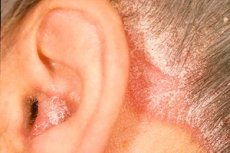Medical expert of the article
New publications
Eczema of the auricle and external ear canal: causes, symptoms, diagnosis, treatment
Last reviewed: 04.07.2025

All iLive content is medically reviewed or fact checked to ensure as much factual accuracy as possible.
We have strict sourcing guidelines and only link to reputable media sites, academic research institutions and, whenever possible, medically peer reviewed studies. Note that the numbers in parentheses ([1], [2], etc.) are clickable links to these studies.
If you feel that any of our content is inaccurate, out-of-date, or otherwise questionable, please select it and press Ctrl + Enter.

Causes ear eczema
The causes of eczema are extremely varied. They are divided into general and local. General causes include neurogenic and psychogenic factors, allergies to certain substances, diseases of internal organs and the endocrine system. Local causes may include contact with certain irritants, skin infection during scarification, abrasions when wearing special clothing, discharge of purulent contents from the ear, etc.
 [ 3 ]
[ 3 ]
Symptoms ear eczema
Eczema of the auricle and external auditory canal occurs acutely, then becomes chronic with a tendency to relapse. The following forms of eczema are distinguished: true, professional, microbial and seborrheic.
True eczema in the acute period is characterized by a rash on erythematous, slightly edematous skin of microvesicles, which, quickly opening, form a large number of small point erosions with drops of serous exudate (symptom of "dew") - acute weeping eczema. Some of the vesicles dry up without opening, form crusts, and at the same time new vesicles appear. Thus, eczema is characterized by polymorphism of rashes, when all its pathomorphological elements are on the surface of the affected area of the skin - erythema, vesicles, erosions, crusts and scales.
Professional (contact) eczema is more often observed with increased sensitivity to various substances encountered at work. In this case, the skin of the face, back of the hands, etc. is usually affected.
Microbial eczema develops as a result of irritation and secondary eczematization of superficial pyoderma, purulent discharge from the ear or nose, etc. The transition from the acute form to the chronic form is characterized by a significant decrease in skin hyperemia, the appearance of islets of its normalization on the affected areas, but the eczematous process itself continues in a more sluggish form of the course.
An abortive form of eczema is eczematid, characterized by multiple, less often single, itchy erythematous flaky spots of oval and round outlines of various sizes. When they are irritated, drop-like oozing occurs. These rashes can occur after tonsillitis, acute respiratory and intestinal diseases, and flu.
Children suffering from exudative-catarrhal diathesis often develop eczema, most often localized in the face and scalp, and accompanied by severe exudation and severe itching.
Where does it hurt?
Complications and consequences
Infection of eczema foci with pyogenic microorganisms during scratching, especially often in children, which can develop into impetigo. Seeding with introduced staphylococcus can lead to local or widespread furunculosis. The consequences of eczema of the external auditory canal when it becomes infected can lead to stricture or atresia of the auditory canal.
What do need to examine?
How to examine?
What tests are needed?
Who to contact?
Treatment ear eczema
Treatment is divided into general and local, and in some cases, especially in neurogenic forms, general treatment can play a decisive role.
General treatment
Includes the administration of sedatives, intravenous infusion of 10% calcium chloride solution, 30% sodium thiosulfate solution, etc., multivitamins, especially ascorbic acid, vitamin P preparations (rutin, ascorutin, quercetin, etc.), aevit, nicotinic acid, B vitamins. In some cases, antiallergic drugs give a good effect in complex general treatment.
Local treatment
In case of eczema of the external auditory canal in the acute period, it is washed with a 1:1000 furacilin solution, 1% resorcinol solution, etc. to reduce exudation, prevent secondary infection and the formation of epidermal plugs. Then, after drying the ear canal cleared of various types of eczematization products, its skin is sparingly treated with a 2% silver nitrate solution, after which it is loosely tamponed with dry ear turundas for 24 hours. The procedure is repeated for 2-3 days, then ointments and pastes with corticoid preparations are used.
In acute auricular eczema, with severe weeping and swelling, cold, frequently changed compresses or wet drying dressings with astringent solutions (lead water, 1% resorcinol solution, etc.) are indicated; in the subacute period, with slight weeping and predominant peeling, naphthalan or ichthyol (2-5%) pastes and ointments, as well as creams with corticosteroids.
In the case of a chronic course of the process and the presence of pronounced infiltration of the affected areas of the skin, keratoplastic agents are used (tar preparations, naphthalan paste in a gradually increasing concentration - from 2-5 to 10-25%). Attention is paid to the neurological and psycho-emotional status of the patient with the correction of possible neurotic states, it is important to follow a diet for eczema. It is important to eliminate the causes of eczema (focal infection, smoking, excessive consumption of alcoholic beverages, exposure to allergic factors and industrial - chemical and radiation - hazards).
More information of the treatment
Forecast
The prognosis for life is favorable; in terms of recovery, it depends on the possibility of eliminating the causes that cause changes in skin reactivity and disruption of its homeostatic and protective properties.
 [ 10 ]
[ 10 ]

